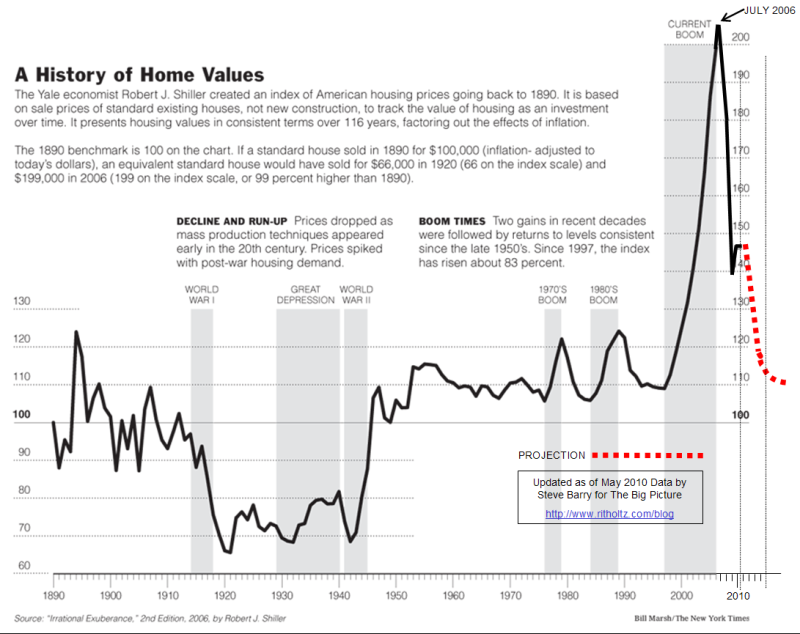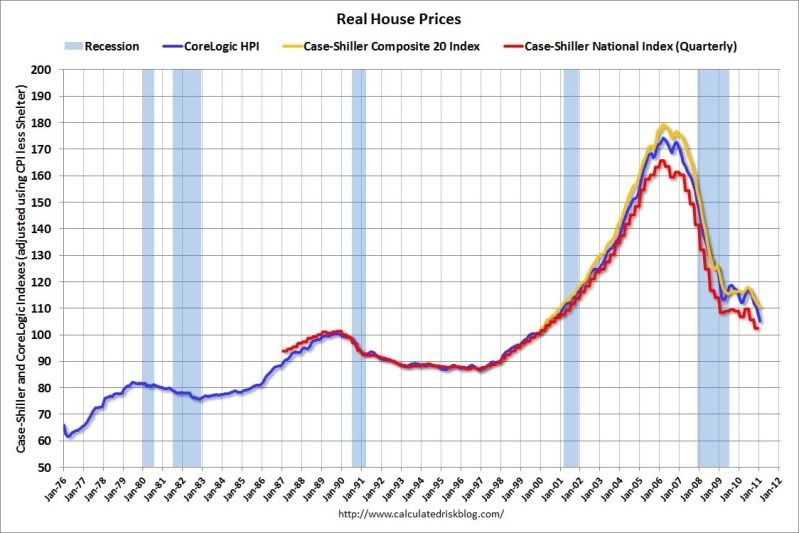(2 pm. – promoted by ek hornbeck)
Real estate agent Steve Thoele is “curious” about the continuing decline in housing prices:
“You do kind of wonder where the bottom is,” said Mr. Thoele. “Sellers know in the back of their mind that their home is worth less than at the peak, but they’re still a little surprised when you tell them their $400,000 house is now worth $300,000.”
I kind of wonder, too. Uh-huh. If only there were data on home prices spanning back, say, a hundred years or so, that might indicate a somewhat stable historical mean house price. Oh, wait a minizzle…what’s this?
This graph of the Case-Shiller index over the past hunnert-twenty years, or so, (last updated to 2010) shows that homes began outrageously over-shooting their historical value starting in about 1996-97. The plot thickens. It was a dark and stormy night. A shot rang out! Where could that housing bottom (and those weapons of mass destruction) possibly be?
I thought I recently heard Herr Doktor Shiller suggesting a further 15% to 20% to 25% drop in prices. Or was that my national psychosis talking?
Wait. What’s this visual hallucination irrupting into my consciousness? Another update on current real house prices?
Shazzam! It looks like prices have to drop another 20% to 25% from peak before they regress to the historical mean! Herr Doktor Shiller, who coulda know’d?
Karl Case:
“The spring market could have some good surprises,” said Mr. Case, the economist.
“I say that with absolutely no conviction.”
I mean, you only helped create the friggin’ index, chappie.
As a person who has zero-fucking-intrinsic-interest in real estate, but having some minimal courage of convictions, I’m predicting at least a 20% to 25% further drop from peak, to the historical mean. Fuck 15%. Fifteen percent is for pussies.
As for the over-shoot in prices regressing only to the historical mean, which will be plenty damaging enough, considering we never reformed the banks and threw their executives in jail…where’s the bottom during wars and depressions? Again, refer to “1917” on the Case-Shiller chart. Let’s not get hysterical, but can anyone say “undershoot?”
And having bankrupted the global economy and passed carrying capacity, can anyone say, “permanent undershoot,” “demand destruction,” or more simply, “die-off?”



10 comments
Skip to comment form
Author
BP’s Deep Horizon, Fukushima, and Libya are also all unrelated.
Obama: Is my ass hanging out?
needs a bottom to acquire all those homes at so they can sell them at a profit in the rising market that will immediately follow them acquiring them so they can then drop the bottom out of them again coincidentally just before they reacquire them so they can sell them at a profit in the rising market that will immediately follow them acquiring them so they can then drop the bottom out of them again coincidentally just before they reacquire them so they can sell them at a profit in the rising market that will immediately follow them acquiring them so they can then drop the bottom out of them again coincidentally just before they reacquire them so they can sell them at a profit in the rising market that will immediately follow them acquiring them so they can then drop the bottom out of them again coincidentally just before they reacquire them so they can sell them at a profit in the rising market that will immediately follow them acquiring them so they can then drop the bottom out of them again coincidentally just before they reacquire them so they can sell them at a profit in the rising market that will immediately follow them acquiring them.
Don’t they?
Even for a pro-business outfit like Bloomberg, some “business” is just too fucking dirty, as described in their recent headline…
So why is this business so fucking dirty, and how does it confuse Case-Shiller?
So a house that sells right now with a (seller-financed) mortgage of $200,000 was actually sold twice, first for a cash discount of 36%, for $138,000, and then for the mortgage-market price of $200,000, so…
The average price of the two transactions was $169,000…
…even though what used to be a typical home-buyer pays $200,000.
And the Case-Shiller index (partially) reflects this artificial depression of average prices.
raise rents on their rentals. It’s a double win for these predators, and the poor get poorer as they are also hit with higher interest rates on autos, appliances etc.
http://www.huffingtonpost.com/…